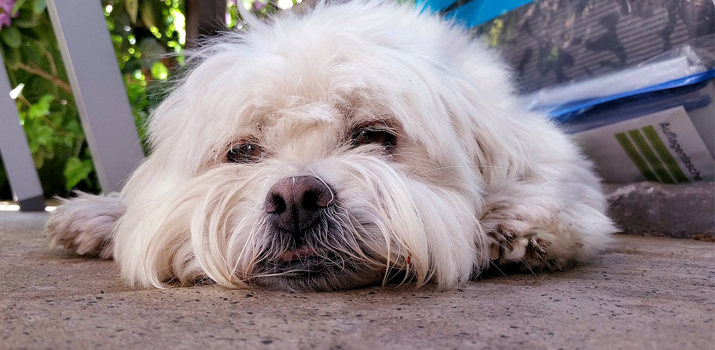If you have ever walked in on your dog sleeping with their eyes open, you know how unusually fascinating the sight can be. Your dog can be in a deep sleep, snoring and all, but still look like their fully awake.
It's like a scene straight out of the cartoons. You may be thinking, "How is that even possible?"

There are a few reasons why this may be happening. For the most part, it's not a huge cause for concern. However, there may also be an underlying reason why your dog's eyes aren't closed when their sleeping.
To ensure that your dog is safe, happy, and healthy, you need to pay close attention to their behavior.
Are My Dog's Eyes Really Open?
The first thing you need to do is make sure that your dog's eyes are actually open. There's a big difference between wide-open eyes and partially closed eyes during sleep.
In most cases, your dog's eyes will be partially closed.
Other than that, they may look relaxed and peaceful. If that's the case, your dog is simply dreaming away.
Partially Open Eyes During Sleep
Some breeds are more prone to keeping their eyes open at night than other.
Short-faced dogs, such as Pugs and Shih Tzus, often have a condition known as Lagophthalmos. Essentially, it's a condition that prevents their eyes from closing all the way.
They can blink normally to keep debris out of their eyes. However, when they're sleeping and don't have control over their muscles, the eyes will stay partially open.
Defensive Instincts
Another reason why your dog's eyes may remain open during sleep is their instincts.
In the wild, dogs will sometimes sleep with their eyes open to fool passing animals. They look awake, so they're less likely to be bothered by larger beasts who are looking for their next meal.
While hundreds of years have passed since most breeds have been in the wild, those instincts tend to stay.
The Hidden Third Eyelid
So if your dog is sleeping with their eyes slightly open, how are they staying comfortable?
Dogs have a third eyelid. It's called the nictitating membrane. It's responsible for producing about half of your dog's tears.
When your pooch is awake, that membrane retracts to the inner corner of their eye. However, you may still see it from time to time. It's a light pink tissue that moves laterally over their eyeball, kind of like a windshield wiper.
The unique thing about this third eyelid is that your pup doesn't really have control over its movement. When your dog closes their eye, it moves back into the orbital socket a bit. This triggers the membrane to slide across the surface of the eye.
Even if your dog's eyes are slightly closed, it'll move to provide protection. The third eyelid works to keep the eye lubricated and free of debris.
The Dangers of a Damaged Membrane
While we don't see the membrane that much, it does a lot to keep your dog's eyes healthy and comfortable. It's important that issues with the membrane are addressed immediately. One of the most common issues is Cherry Eye.
Essentially, the cartilage that supports the eyelid falls. It can't support the eyelid's movements. You may be able to see the eyelid at all times, even when your dog is awake.
Because it can't move, it's constantly exposed to dirt and grime. This could lead to infection.
Dogs with Lagophthalmos need to have a healthy third eyelid. Otherwise, they're at risk for experiencing serious ocular issues.
When Should You Be Concerned?
If your dog's eyes are only partially opened while they sleep, there's usually no need to worry.
Their third eyelid is working to keep them safe. However, if there is movement associated with the open eyes, there may be something else going on.
These movements may indicate that your dog is dreaming or having a seizure. To make sure that you can get your dog the help they need, you must be able to distinguish the two.
Vivid Dreams
Dogs will often twitch while they're having vivid dreams.
Canines are a lot like humans in that sense. It's believed that dogs twitch when they're in the REM stage. The REM stage, or rapid eye movement stage, is the deepest state of sleep.
For humans, this is when dreaming occurs. It's theorized that the same is true for canines. Your dog may be dreaming of running around an open field or chasing a bunny.

The movement caused by dreaming is completely normal.
You may notice your dog twitch aggressively or kick at the air. Sometimes, it's even accompanied by soft moans or muffled yipping.
In most cases, this strange behavior only lasts for a few moments.
If you're worried about the twitching, you can take a close look at their eyes. The eyes should only be partially opened. Aside from the twitching, your dog should look peaceful. Pay close attention to their breathing. If it seems normal, then there's no reason to worry.
Waking the Pup
As a last ditch effort to know for sure that they're only dreaming, you can wake your pup up. The behavior they exhibit after waking up can be a good indicator of what was really going on.
Say their name gently to take them of their sleep.
You should never shake your dog or wake them up suddenly, especially if they were dreaming. Your precious pooch may think they're still dreaming for a split second and bite you.
After they've woken up, they should have no problem popping back up and returning to their normal routine. They'll act as if nothing strange was happening at all.
Seizures
Seizures are a neurological disorder that can be very frightening to witness.
The things your dog does during a seizure are completely involuntary. Seizures can occur at any time without much warning.
Sometimes, they happen when your dog gets very excited. However, other times, they can happen when your dog is sound asleep.
Related: Why your Dog Suddenly Prefers Sleeping on the Floor
Seizures vs Twitching
There's a distinct difference between jerking from a seizure and twitching. The movements will seem more aggressive. Dogs can start thrashing around, kicking, and shaking. They can also cause other bodily harm.
For example, it's not uncommon for dogs to bite down on their tongues so hard during a seizure that they may start bleeding. Other physical signs may also be present.
Your dog can start foaming at the mouth and lose control of their bowels. Depending on the severity of the seizure, dogs can have accidents, vomit, and scream. It can be very alarming to watch.
What to Do When it Happens?
Unfortunately, there's nothing you can do during a seizure to provide your dog with relief. It's recommended that you don't try to restrain them. You have to let it run its course.
The best thing you can do is move hazards away from your dog to prevent injury and wait patiently. Then, bring your dog to a vet as soon as possible.
If you suspect that your dog is having a seizure, you can take a close look at their eyes.
Instead of being partially open, the eyes may be fully opened with a blank stare. Your dog's eyes may not be responsive at all. As for breathing, it will be labored.
After the seizure has passed, your dog will not return to normal right away. They'll be disoriented and very scared. Most dogs aren't even able to walk immediately after a seizure.
Final Thoughts
Seeing your dog sleeping with his or her eyes open can be weird at first. It's a creepy thing to witness, especially if it's something your dog has never done before.
As long as their third eye is healthy, there's usually no reason to panic. Just keep an eye on your dog and pay close attention to their body language.
*By knowing the difference between sweet dreams and involuntary seizures, you can take action to give your dog the help they need.
Also read:

